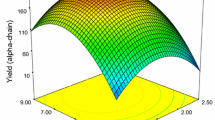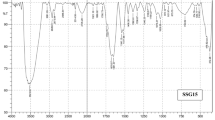Abstract
A factorial design and response surface methodology were used to optimize the extraction process of tilapia skin gelatin (Oreochromis urolepis hornorum). The concentrations of NaOH (0.15%–0.35%) and H2SO4 (0.15%–0.35%), the extraction temperature (40°C–60°C), and the extraction time (3–15 h) were independent variables. Response variables were yield (%), viscosity (mPa·s), and gel strength (g). The NaOH (%) and H2SO4 (%) concentrations had significant influences (p<0.05) on viscosity and gel strength, while the extraction temperature (°C) and the extraction time (h) showed significant influences (p<0.05) on all dependent variables. Increasing the temperature and extraction time provided higher yields with a reduction in the gelatin viscosity and gel strength. Tilapia fish skin can be used as a source for production of gelatin.
Similar content being viewed by others
Refrerences
Gómez-Guillén MC, Montero P. Extraction of gelatin from megrim (Lepidorhombusboscii) skins with several organic acids. J. Food Sci. 66: 213–216 (2001)
Johns P, Courts A. Relationship between collagen and gelatin. 138–177. In: The Science and Technology of Gelatin. Ward AG, Courts A (eds). Academic Press, London, UK (1997)
Gildberg A, Arnesen JA, Carlehög M. Utilisation of cod backbone by biochemical fractionation. Proc. Biochem. 38: 475–480 (2002)
Shahidi F. Seafood processing by-products. 320–334. In: Seafoods Chemistry Processing, Technology and Quality. Shahidi F, Botta JR (eds), Blackie Academic and Professional, London, UK (1994)
Gómez-Guillén MC, Turnay J, Fernández-Díaz MD, Ulmo N, Lizarbe MA, Montero P. Structural and physical properties of gelatin extracted from different marine species: A comparative study. Food Hydrocolloid. 16: 25–34 (2002)
Duan R, Zhang J, Xing F, Konno K, Xu B. Study on the properties of gelatins from skin of carp (Cyprinuscarpio) caught in winter and summer season. Food Hydrocolloid. 25: 368–373 (2011)
Montero P, Gómez-Guillén MC. Extracting conditions for megrim (Lepidorhombusboscii) skin collagen affect functional properties of the resulting gelatin. J. Food Sci. 65: 434–438 (2000)
Fernández-Díaz MD, Montero P, Gómez-Guillén MC. Effect of freezing fish skins on molecular and rheological properties of extracted gelatin. Food Hydrocolloid. 17: 281–286 (2003)
Tabarestani HS, Maghsoudlou Y, Motamedzadegan A, Mahoonak AR. Optimization of physico-chemical properties of gelatin extracted from fish skin of rainbow trout (Onchorhynchus mykiss). Bioresource Technol. 101: 6207–6214 (2010)
Alfaro AT, Fonseca GG, Costa CS, Prentice C. Effect of extraction parameters on the properties of gelatin from King weakfish (Macrodon ancylodon) bones. Food Sci. Technol. Int. 15: 553–562 (2009)
Grossman S, Bergman M. Process for the production of gelatin from fish skins. US Patent 5,093,474 (1992)
Gudmundsson M, Hafsteinsson H. Gelatin from cod skins as affected by chemical treatments. J. Food Sci. 62: 37–39 (1997)
Box GEP, Hunter WG, Hunter JS. Statistics for Experimenters. A. John Wiley & Sons, Inc., Publication., New York, NY, USA. 98–113 (1978).
BSI. Methods for Sampling and Testing Gelatin (Physical and Chemical Methods). British Standards Institution, London, UK (1975)
AOAC. Official methods of analysis of AOAC International. 17th ed. Association of Analytical Communities, Gaithersburg, MD, USA (2000)
Johnston-Banks FA. Gelatin. 233–285. In: Food Gels. Harris P (ed). Elsevier, Applied Food Science Series, London, UK (1990)
Boran G, Mulvaney SJ, Regenstein JM. Rheological properties of gelatin from silver carp skin compared to commercially available gelatins from different sources. J. Food Sci. 75: 565–571 (2010)
Alfaro AT, Fonseca GG, Prentice C. Enhancement of functional properties of Wami tilapia (Oreochromis urolepis hornorum) skin gelatin at different pH values. Food Bioprocess. Tech. 5: 1–10 (2012)
Zhou P, Regenstein JM. Optimization of extraction conditions for Pollock skin gelatin. J. Food Sci. 69: 393–398 (2004)
Koli JM, Basu S, Nayak BB, Patange SB, Pagarkar AU, Gudipati V. Functional characteristics of gelatin extracted from skin and bone of Tiger-toothed croaker (Otolithesruber) and Pink perch (Nemipterusjaponicus). Food Bioprod. Process. 90: 555–562 (2012)
Ladislaus M, Kasankala YX, Weilong Y, Sun DH, Qian H. Optimization of gelatine extraction from grass carp (Catenopharyngodonidella) fish skin by response surface methodology. Bioresource Technol. 98: 3338–3343 (2007)
Sperling LH. Introduction to Physical Polymer Science. 4th ed. John Wiley & Sons, Inc. Publication, New York, NY, USA. p. 440 (2006)
Arnesen JA, Gildberg A. Preparation and characterisation of gelatine from the skin of harp seal (Phoca groendlandica). Bioresource Technol. 82: 191–194 (2002)
Muyonga JH, Cole CGB, Duodu KG. Extraction and physicochemical characterisation of Nile perch (Lates niloticus) skin and bone gelatin. Food Hydrocolloid. 18: 581–592 (2004)
Montero P, Fernández-Díaz MD, Gómez-Guillén MC. Characterization of gelatin gels induced by high pressure. Food Hydrocolloid. 16: 197–205 (2002)
Jongjareonrak A, Rawdkuen S, Chaijan M, Benjakul S, Osako K, Tanaka M. Chemical compositions and characterisation of skin gelatin from farmed giant catfish (Pangasianodongigas). LWT-Food Sci. Technol. 43: 161–165 (2010)
Cho SM, Gu YS, Kim SB. Extracting optimization and physical properties of yellowfin tuna (Thunnus albacares) skin gelatin compared to mammalian gelatins. Food Hydrocolloid. 19: 221–229 (2004)
Mohtar NF, Perera C, Quek S. Optimisation of gelatine extraction from hoki (Macruronusnovaezelandiae) skins and measurement of gel strength and SDS-PAGE. Food Chem. 122: 307–313 (2010)
Author information
Authors and Affiliations
Corresponding author
Rights and permissions
About this article
Cite this article
da Trindade Alfaro, A., Fonseca, G.G., Balbinot, E. et al. Yield, viscosity, and gel strength of wami tilapia (Oreochromis urolepis hornorum) skin gelatin: Optimization of the extraction process. Food Sci Biotechnol 23, 765–773 (2014). https://doi.org/10.1007/s10068-014-0103-7
Received:
Revised:
Accepted:
Published:
Issue Date:
DOI: https://doi.org/10.1007/s10068-014-0103-7




